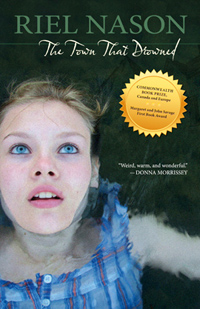Reviews
Fiction Review by Donna Kane
Riel Nason, The Town That Drowned (Fredericton: Goose Lane, 2011). Paperbound, 280pp., $19.95.
“The beginning I remember is this.” Not “This is the beginning I remember.” The difference in word order in the opening line of Riel Nason’s The Town That Drowned might seem inconsequential, but it illustrates from the get-go one of the greatest strengths of this book— its careful use of language. The subtle shift in syntax in this first line changes the emphasis of the subject, lessens the certainty of memory. Throughout Nason’s debut novel, the masterful construction gives the book an energy that elevates our engagement with the characters.
Nason has been publishing in literary journals for several years and she has clearly been honing her craft in the process. Her novel has garnered positive reviews across the country, winning the 2012 Margaret and John Savage First Book Award, and the 2012 Commonwealth Book Prize, Canada and Europe Region. It was also a finalist for the 2012 Canadian Library Association Young Adult Book Award. So, what has made this first book so compelling?
In addition to Nason’s knack for language, she possesses an enviable intuitive sense. Nason writes with a keen logic and with the kind of wisdom that comes from an astute understanding of what it is to be human. It is a gift, and Nason brings this gift to the book’s protagonist, fourteen-year-old Ruby Carson. Written in first person, using an interior monologue or diary form, Ruby tells us her story, her recollection of how things went down in her hometown of Haventon, New Brunswick. There is an anticipation of the reader’s response in every line, and this serves to draw the reader in and to actively engage with the characters. Ruby is preternaturally wise, at times even jaded, but the maturity of her character feels genuine and fully formed. The verity of her insights is supported in part by the environment in which she lives. Who doesn’t know a child who has had to grow up fast because of an extenuating circumstance in their life? For Ruby, this circumstance stems from her younger brother, Percy. Percy is as smart as he is odd. These days, we’d probably diagnose him with a form of autism, but, true to the period in which this novel is set (1965), such terminology was not so commonplace. What we do know is Percy doesn’t like change: “It was as if the whole evolving, revolving world was by nature the problem since it would never stay still for him,” says Ruby. “Everyone thought Percy was different when he was really all about being the same.” Percy serves as a compelling symbol in a story where the catalytic event, the creation of a hydroelectric dam, causes everyone in the small New Brunswick town to undergo a change. Prior to the news of the dam, Ruby falls through the ice at a skating party. The conk to her head gives her a vision that she relays to the crowd. Ruby sees her town and its citizens drowned. Her school peers are merciless in their teasing and so, in addition to being associated with Percy, she is given her own “personalized dent in the joy of…existence.” Part of the charm of this book is that the events never take themselves too seriously. When the teasing from her classmates becomes relentless under the rule of reigning bully, June Crouse, Ruby muses, “June Crouse demands that I drown. Her singing is getting better though, more in tune. I even found myself humming ‘Beyond the Sea’ as I got dressed for school.” Ruby’s vision turns out to be accurate down to the naming of a woman unknown to the community until later in the story. But the premonition is handled so deftly it becomes a subtle point of tension, rather than a major part of the story.
Nason’s story is rich with the regional touches of eastern Canada in the 1960s (Ruby’s birthday gift to an elderly neighbour is a pack of Sportsman cigarettes). This level of detail is another of the book’s strengths. From the smell of hot chocolate when Ruby regains consciousness from her fall, to the Nesbitt’s Orange pop bottle sealed with canning wax, Nason imbues every scene with sensory delight. But anything of the quaint or peculiarly local in this book takes a back seat to the voice of Ruby Carson. She is one of a kind.
—Donna Kane









